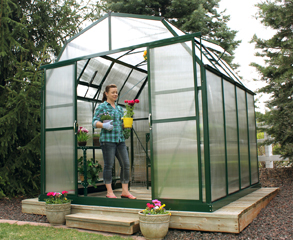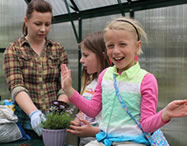Why You Should Purchase a Greenhouse
There are many great reasons to own a greenhouse. When you have a greenhouse, your gardening hobby grows into a full-time passion! A greenhouse is great for everyone who loves plants whether you have hours and hours to devote to gardening or just a few minutes a week. Here are just some of the wonderful things you can do with your own greenhouse. As well as some answers to some questions you might have about owning your Greenhouse.
 Is This For Me?
Is This For Me?
Whether you would like to start seedlings in your greenhouse, grow exotic plants or create your own vegetable garden, a greenhouse is the best way to get outstanding results and to extend your growing season. For many people, taking time to garden in their greenhouse is their favorite way to escape from the chaos of the day. Imagine relaxing while surrounded by colorful, vibrant flowers and pleasant aromas. If relaxation is your goal, be sure to choose a greenhouse that offers good insulation so that it can be used year-round. Try growing plants such as lavender, sweet pea and pansies during colder months to give your greenhouse a cheerful and peaceful feeling. With a little bit of know-how, you can enjoy almost any plant year-round with the right greenhouse.
Why Buy a Greenhouse
You've been to the grocery store lately, beyond the amount you pay for gas and the wear and tear on your car, you want to lay on their floor in the fetal position when you see what they want for some squash these days. But no matter how high the prices get, you keep buying. It's due to our love of flavorful foods and our desire to take care of ourselves. But what if you could keep a few extra bucks in your pocket, eat better vegetables and take up one of the fastest growing hobbies? Maybe it's time to consider a greenhouse. Why should you?
- Saves you money - For the price of some seeds, water and love you can produce unlimited amounts of food. And it's amazing how much better it tastes when it's yours.
- Lets you start the seeds you choose - How much fun is it looking through your favorite seed catalog or gardening store display every year and finding something new and different. It may be a new variety of a flower or a bigger, better tasting tomato. What can be more satisfying than watching this new plant emerge?
- Gives you hours of enjoyment - You'll find that when you have cabin fever in the winter there is no better place to spend some time surrounded by the beauty in your greenhouse.
- Protects your plants in the winter - This one pretty much goes without explanation. Over wintering in a greenhouse is much better than filling up your dining room or garage with plants for the winter. You'll be the envy of all of your friends and neighbors - You'll start the neighborhood trend. Soon you'll have a street full of Greehouses all sharing ideas.
- A peaceful retreat - No cell phones, no TV, just you and nature. Relax and enjoy. The greenhouse is a perfect place for a little quiet meditation.
- Allows you to propagate your favorite plants - You can take cuttings and start new plants for yourself or a friend. Can be profitable - Many people find that even a small greenhouse in their backyard will supply enough to set up a booth at a local farmers market. Or, this can be done on a much larger scale.
- Gives you the means to nurture your prize winning orchids - With a properly set up greenhouse you are able to control the environment and give your orchids what they need for optimum growth.
- You are able to grow your own vegetables - With all of the food scares and the ever growing popularity of "green" living, growing your own food is not only fun, it is a wise and environmentally good choice.
How Big Should My Greenhouse Be?
Select a greenhouse as large as your site and budget will allow. Greenhouse gardeners inevitably wish they had more space to accommodate their growing plants. Again, adequate height is important for your comfort as well as providing room for shelves and hanging plants. Additional growing space can be provided with a shorter base wall that allows for more under-shelf growing space as well as shelves along the walls.
Will A Greenhouse Save Me Money?
Greenhouses are a great way for many gardeners to save money. With a greenhouse, gardeners can overwinter many of their favorite plants, reducing the number that they buy at expensive nurseries. While some gardeners easily start their plants from seeds in order to save money each year, other gardeners appreciate the fact that they can grow their own nutritious food instead of purchasing it. However, for many gardeners, their greenhouse hobby soon develops into a small greenhouse business.
For many enthusiastic gardeners, it is easy to get carried away and end up with more plants than they even have a use for! While these plants of course make wonderful gifts, they are also easy to sell. In fact, some ambitious gardeners have been able to pay for their entire greenhouse in a single season by selling their seedlings. Plants such as tomatoes and peppers are especially popular choices among buyers. Also consider growing pots of flowers that can be sold for Easter or Mother's Day. Some people choose to sell their plants from home, but others have had success selling at farmers' markets or other local gatherings. To begin with, you could simply dedicate a small portion of your greenhouse towards plants to be sold at an upcoming garage sale.
While purchasing a greenhouse is initially a big investment, it is important to remember that it certainly has its pay-offs. In addition to the pleasure it brings to your life, it can also pay for itself in time by helping you to save money on your favorite plants. If you are fortunate enough to have the time and space, consider turning your hobby into a small business that will make your greenhouse gardening experience an even bigger success.
Do I need a building permit for my greenhouse?
Greenhouses tend to be in a building code "twilight zone". Local codes and code interpretations vary greatly between counties and even between individuals within the same department! Compliance is the responsibility of the buyer. Generally we have found that a free standing greenhouse with a size of less that 120 sq.ft. usually does not require a permit. Lean-to Greenhouses attached to a wall of the house or garage, even if they are less that 120 sq.ft., are sometimes considered living space and subject to stricter rules. Getting a permit can be as simple as providing basic greenhouse plans and as complicated (and expensive) as having a state licensed engineer approve the plans. Should you choose to obtain a permit it is best to get it before placing a greenhouse order in case there are changes that need to be made to comply with codes. We will do our best to help you through this process.
What different greenhouse types are available?
There are many different choices for greenhouse styles. A Lean-to greenhouse is attached to the wall of a building; often a convenient structure for access from the house and easier to heat because one side is a solid wall. A free-standing greenhouse stands on its own and can be located almost anywhere. The glass sides of the greenhouse can be tall or short depending on your growing and storage needs. A bench-high base wall (or knee wall) provides for storage space under the benches and the greenhouse will be easier to heat because the base wall can be insulated. A shorter base wall allows for light under the benches for more growing space (keep in mind this lower space can be awkward to get to) and maximum solar heating. When purchasing a greenhouse, it is important to be aware of the total height of the greenhouse to be sure it is adequate for you and your plants. You'll easily be able to find a greenhouse to suit your needs
What accessories are needed in the greenhouse?
- Circulating fan: Air movement is essential for a healthy greenhouse environment and helps to reduce heating costs and condensation. We recommend continuous, gentle air movement 24/7 provided by an oscillating fan or quiet re-circulating type fan.
- Heater: Type and size of heater needed depends of the size of the greenhouse and the inside and outside temperatures involved. Gas (natural or LP, vented or non- vented) or electric (120V or 240V) heaters can be used. To make a 120V heater more effective add an additional thermostat to turn the heater on and off at specific temperatures.
- Coolers: In very hot climates sometimes positive cooling is needed. Air conditioners should not be used because they de-humidify the greenhouse. Nature's most efficient means of cooling is through the evaporation of water. Evaporative air coolers work by drawing hot air through wet pads using a fan or blower. Water evaporates from the pads, providing cool, clean, humid air.
- Humidifier or mister: Plants need adequate humidity when greenhouse temperatures move up. Generally, wetting down a porous (bricks, gravel) floor periodically is the easiest method for creating humidity. An automatic humidifier or a misting/fogging system may be used if additional humidity is needed.
- Shading: The need for shading depends on sun exposure and plants being grown. Ways to shade include shade cloth, shading paint, roll-up shades and fiberglass panels. Custom-fit shade cloth panels can be added to all or part of the greenhouse. Attached to the outside of the greenhouse, they are effective, neat in appearance, easy to use, economical, reusable and available in a variety of densities.
- Propagation Mats: With good bottom heat, propagation is easy and fast, even in a cool greenhouse. Propagation mats are great for supplying heat to plants in containers, seed flats, etc.
- Shelves & Benches: To maximize efficient use of your greenhouse, some type of benches and/or shelves will be needed. Many options are available and will depend on the size and style of your greenhouse.
Where do I set up my Greenhouse?
When deciding where to put your greenhouse, think about how your greenhouse will best fit in with your home's landscaping, what kind of exposure it will have to sunlight, wind and weather, your convenience of access and the physical ease of construction and installation. For sun exposure, generally a southeasterly exposure is best for gardening, with east, south, then west exposures following in that order. Adequate natural light is essential for successful greenhouse gardening, although it is possible to supplement with artificial lights. For solar heating, a southerly exposure is best.



